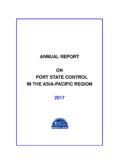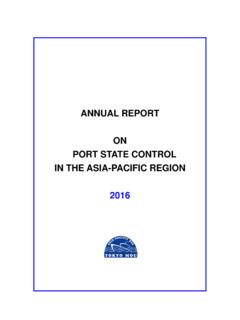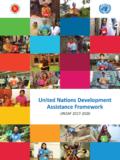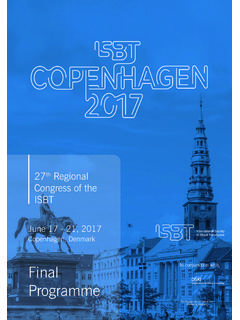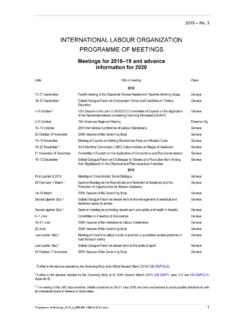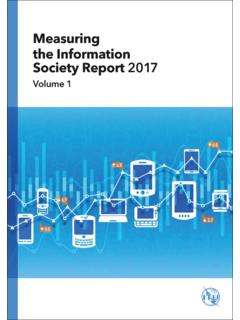Transcription of NATIONS EP - Minamata Convention on Mercury
1 K1707183 140717 UNITED NATIONS EP UNEP/ United NATIONS Environment Programme Distr.: General 2 July 2017 English only conference of the Parties to the Minamata Convention on Mercury First meeting Geneva, 24 29 September 2017 Item 6 (h) of the provisional agenda* Matters stipulated by the Convention for action by the conference of the Parties: the definition of Mercury waste thresholds referred to in paragraph 2 of article 11 Informal process on the establishment of Mercury waste thresholds led by the Government of Japan Note by the secretariat As its seventh session, the intergovernmental negotiating committee to prepare a global legally binding instrument on Mercury recommended that informal efforts to propose appropriate Mercury waste thresholds be pursued by those with the relevant expertise (see UNEP(DTIE)/ , para 210).
2 Subsequently the Government of Japan facilitated discussions on such thresholds in the context of the Minamata Convention on Mercury under the aegis of the United NATIONS Environment Programme s Global Mercury Partnership, including the Partnership s Mercury Reduction in Products Area and Mercury Supply and Storage Area. The draft paper developed as a result of those discussions was presented by the Government of Japan at Minamata Convention working sessions held in March 2017 , and the participating countries, international organizations and non-governmental organizations, as well as members of the participating areas of the UNEP Global Mercury Partnership, were asked to comment on it. A revised draft of the paper, incorporating the comments received, is annexed to the present note for the information of the conference of the Parties to the Minamata Convention at its first meeting.
3 It is presented as received, without formal editing. * UNEP/ UNEP/ 2 Annex Recommendations on proceeding discussions on thresholds for identification of Mercury wastes under the Minamata Convention 1. Background (1) Definition of wastes under the Minamata and Basel Conventions Article 11 of the Minamata Convention on Mercury (hereinafter referred as the Minamata Convention ) provides that the relevant definitions of the Basel Convention shall be applied or used as guidance to wastes covered under the Minamata Convention . Article 2 of the Basel Convention on the Control of Transboundary Movements of Hazardous Wastes and Their Disposal (hereinafter referred as the Basel Convention ) defines wastes as substances or objects which are disposed of or are intended to be disposed of or are required to be disposed of by the provisions of national law.
4 (2) Definition of Mercury wastes under the Minamata Convention Article 11 of the Minamata Convention defines Mercury wastes as substances or objects: (a) Consisting of Mercury or Mercury compounds; (b) Containing Mercury or Mercury compounds; or (c) Contaminated with Mercury or Mercury compounds, in a quantity above the relevant thresholds defined by the conference of the Parties, in collaboration with the relevant bodies of the Basel Convention in a harmonized manner, that are disposed of or are intended to be disposed of or are required to be disposed of by the provisions of national law or this Convention . Article 11 of the Minamata Convention also prescribes that each Party shall take appropriate measures so that Mercury waste is: (a) Managed in an environmentally sound manner, taking into account the guidelines developed under the Basel Convention (hereinafter referred as Basel Guidelines or BG ) and in accordance with requirements that the conference of the Parties shall adopt in an additional annex in accordance with Article 27 (hereinafter referred as the management requirements ).
5 In developing requirements, the conference of the Parties shall take into account Parties waste management regulations and programmes; (b) Only recovered, recycled, reclaimed or directly re-used for a use allowed to a Party under this Convention or for environmentally sound disposal pursuant to paragraph (a); (c) For Parties to the Basel Convention , not transported across international boundaries except for the purpose of environmentally sound disposal in conformity with Article 11 of the Minamata Convention and with the Basel Convention . In circumstances where the Basel Convention does not apply to transport across international boundaries, a Party shall allow such transport only after taking into account relevant international rules, standards, and guidelines.
6 (3) International discussions Countries were requested to provide the interim secretariat of the Minamata Convention with information on national use of thresholds for identifying Mercury waste and regulations at the sixth session of the International Negotiating Committee on Mercury (INC6) held in November, 2014. The interim secretariat of Minamata Convention undertook inter-sessional work and compiled the submissions and presented the report to INC7 held in March 2016. Since the information provided before INC7 was insufficient, countries were requested at INC7 to provide additional information so that informal discussions in relation to such thresholds can occur among the countries prior to the first conference of the Parties (COP1). The report of INC7 reads: 210.
7 Following its discussion, the committee decided that the secretariat should collect additional information on the use of Mercury waste thresholds from Governments and others and that informal efforts to propose appropriate thresholds should be pursued by those with the relevant expertise. Interim secretariat called for additional information to governments and others and 6 countries and EU responded and submitted the information on Article 11. UNEP/ 3 2. Process (1) Forming an informal discussion group After INC7, UNEP requested Japan, as the lead country of the Mercury Waste Management Area under the UNEP Global Mercury Partnership, to take the lead in informal discussions with respect to thresholds for identifying Mercury wastes. Therefore, Japan proposed to facilitate discussions on such thresholds under the Minamata Convention within the UNEP Global Mercury Partnership in cooperation with the Mercury Reduction in Products Area, and the Mercury Supply and Storage Area.
8 (2) Preparatory works The partnership leads and other volunteer experts exchanged views and ideas on the process and discussion points of the Mercury waste thresholds. The initial discussion paper was prepared by Japan, which was circulated among partners of the three partnership areas under the UNEP global Mercury partnership. It was also introduced at the UNEP-IETC workshop on global Mercury waste assessment held in Thailand in November 2016. After reviewing the comments received by mid-January 2017 , the previous draft of this paper was prepared for recommending COP1 to take further actions. (3) Informal consultation The earlier draft of this paper was presented at the Minamata Working Sessions held in conjunction with the regional preparatory meetings for the BRS 2017 COP, and the participating countries, international organizations, and NGOs as well as members of the three areas of the UNEP Global Mercury Partnership were asked to provide comments on the earlier draft by the end of April 2017 .
9 By the end of April 2017 , nine stakeholders provided comments. Based on those comments, the earlier draft was revised. 3. Proposed further actions (1) Establishment of an ad hoc intersessional working group As the Minamata Convention will enter into force on 16 August 2017 (the COP1 of the Minamata Convention is scheduled during the last week of September 2017 ), formal discussion on thresholds for identification of Mercury wastes under the Minamata Convention should be started as soon as possible. The issue is highly technical in some parts[and also involves many administrative implications]. A possible way to proceed the formal discussion would be to establish an ad hoc intersessional working group (between COPs) to discuss and develop recommendations on the Mercury waste thresholds to the subsequent COPs.
10 (2) Structure of the intersessional working group The group will be composed of 19 members nominated by each of the five UN regions. The distribution of the seat allocation is suggested as follows: African States: 3 Asia-Pacific States: 5 Central and Eastern European States: 2 Latin American and Caribbean States: 3 Western European and other States: 6 The group will elect two co-chairs and [may] invite[, as appropriate,] the participation of [four] experts from industry and civil society [two from industry and two from civil society] as observers. The group will widely invite inputs to their documents from other governments, intergovernmental organizations, industry and civil society organizations. [The expert group should work as much as possible using electronic means that reduce the need for costly face-to-face meetings.]



